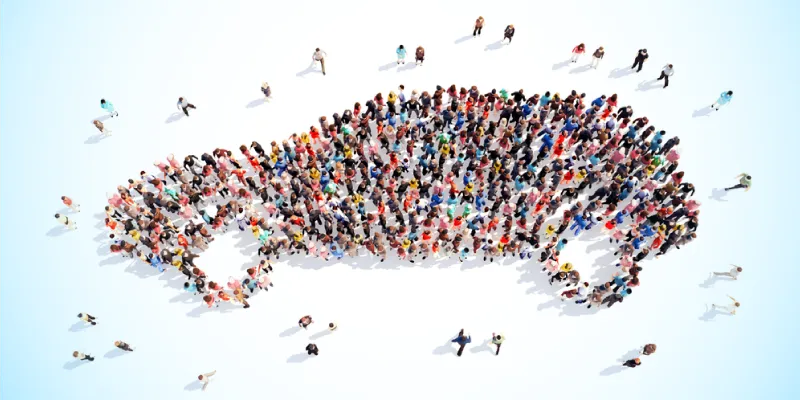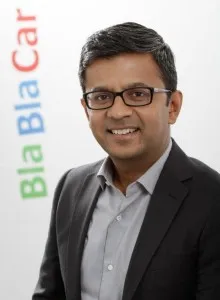With zero investment, BlaBlaCar drives more than 3mn rides in 18 months
When French-born ridesharing platform BlaBlaCar drove into India in January 2015, the country was witnessing the biggest transformation in its intra-city travel. Led by home grown cab aggregator startup Ola and global giant Uber, the startup revolution has changed the way Indians travel inside cities.

But inter-city rides were still open for innovation. That’s where BlaBlaCar started a silent disruption. Now present in 22 countries, India was their first choice in Asia. Peer-to peer ridesharing for long distance was a new concept in India. There were concerns of safety and reliability. Yet, in 18 months, BlaBlaCar finished more than three million rides, and is charging for four million by the end of 2016. The 10-year-old company raised $200 million in September 2015.
In a recent interaction with YourStory, Raghav Gupta, India Country Manager, talked about BlaBlaCar’s journey. With no resources but their technology, BlaBlaCar has broken into India.
Step by step
For the first six to seven months, BlaBlaCar focused on educating people on the completely new model of long distance travel by ridesharing. “Once they started using BlaBlaCar, we started renovating according to their feedback to make our model more relevant to users. In the last six months, we have seen a strong uptake of the service,” says Raghav.
Most users of this model are young business professionals, small retailers, tech savvy college students, and corporate professionals in the 35-58 age group. Since fuel is expensive, and travelling alone for a long stretch is monotonous, many people who used to travel alone are willing to share their empty seats. Once you ‘offer a ride’ and feed the distance, it tells you how much you can charge. You can bring down the rate if you wish. Users can check your profile before sending you a booking request.
Raghav says that in Europe, BlaBlaCar is cheaper than trains. In India, BlaBlaCar has a slight advantage over the Shatabdi Express; travelling by the train from Bengaluru to Chennai costs Rs 700-800, whereas BlaBlaCar costs Rs 650-700. But their value proposition is availability. For trains, very often, your ticket is in the waiting list. With BlaBlaCar, availability is possible even at the last minute. In fact, BlaBlaCar has tied up with IRCTC, so that those who are waitlisted for a ticket have the option of using BlaBlaCar. It instils confidence in the user as a government body is promoting it.
Raghav claims that those who drive down between cities on a regular basis can bring down their annual cost of petrol by Rs 50,000 through sharing.
Innovations for India
Are Indians open to the sharing economy? Raghav says, “The concept of personal space is important in Europe. They need some incentive to participate in the shared economy. But it comes to Indians naturally – we are used to packed trains. If they are nice people, we are happy to share with them. But India needs a slightly more comprehensive trust and safety capability on the platform.”

India is the first country where BlaBlaCar mandated government IDs from users. “For verification, we acquire their mobile number and email id. We also get details on why they are travelling and their general travel habits. Also, at the end of the journey, there is peer-to-peer rating. Women can choose women-only rides too,” says Raghav. He adds that they are taking some of the enhanced verification features to other countries. So far, while delays and cancellations have been known to occur, there has been no harassment or robbery reported.
At the time of their launch, BlaBlaCar took a mobile-first approach. Raghav says, “We expected more traffic on mobile. But most users wanted to test the platform on their desktop before committing to downloading an app as they do not have sufficient memory on their phones. So we changed the mobile-first approach to a full-fledged desktop website.” App size does not matter in Europe as phone memory is efficient. But in India, after getting feedback, they reduced their app size from 20MB to 8MB. A mobile website is also very important for them in India, and they are also considering CoD for payments here.
Busy routes
Most BlaBlaCar users travel more than 100 km one way. BlaBlaCar has already covered more than 500 routes. Raghav says that men travel inter-city more than women do, and most women travel accompanied by men in the North of India.
Among their big city-to-big city routes, Bengaluru to Chennai/Hyderabad, Mumbai to Pune, and Delhi to Chandigarh/Jaipur are the busiest. Among the big city–to-small city ones, Bengaluru to Salem is among the top 10 routes, followed by Bengaluru to Vellore and Delhi to Hizar.
Raghav says that small city-to-small city is yet to take off in India. In routes like Salem to Coimbatore, public transport is not great. Jaspal Singh, Partner at Valoriser Consultants, says that this is a viable option for many small towns that are not connected to each other. “Since they have very few options, they would rather share the resources, depending on urgency. It comes out of compulsion,” he says.
Market share
City-to-city ride sharing is a huge market, and it does not need any investment as no cars need to be purchased. Ibibo Ryde, Pikup, Pool Circle and Carpool Adda follow this model.
Raghav says that BlaBlaCar competes with public transport, not Ola or Uber. Although Uber had piloted P2P ridesharing in Punjab in late 2015, it did not take off. ‘Ola outstation’, while long distance, does not follow a P2P model. Raghav says, “Intercity taxis for families cost Rs 4,000-6,000, including return fare. BlaBlaCar is used when only one or two people are travelling. Uber and Ola do not affect us as they are different segments.”
Ridesharing is about better utilisation of existing resources. This method is environment-friendly, connects more people, provides flexibility, and takes less time than a bus or a train. Meeting the supply-demand balance, however, is a challenge. People often travel with family, so getting an empty seat is not always easy. While Indians may be open to sharing space with others when using traditional public transport, they tend to have a mental block when it comes to sharing a ride with strangers. Jaspal says, “Depending purely on P2P may not work in the long term. BlaBlaCar will need to use commercial vehicles for ridesharing in the future.”
Future driveways
Carpooling, as a concept, comes under the large umbrella of the shared economy, which a recent PwC report estimated at $15 billion globally. This figure is projected to hit $335 billion by 2025. But carpooling is still new in India, and there is still some scepticism surrounding it. Jaspal says, “Youngsters are risk takers, but BlaBlaCar will have to find out their users’ behaviour by collecting data. Government verifications will be time consuming but will provide more confidence.”
Although small cities are the best targets, internet penetration and tech awareness is yet to improve. Raghav believes that India will become one of their top five countries in the next two to five years due to the size of the population and the need of support for public transport. They do not charge members at present.
“The plan is to let the members use the service for two years so that they can see value in the service. Once they start appreciating it, we will start monetising it, with about 15 percent of the cost of the ride for the co-traveller as a commission,” says Raghav.
With the average commuter facing numerous hurdles, not least of which are ubiquitous traffic jams, an overburdened public transport system and steadily rising fuel prices, the disruption we have been seeing in road transport in India seems all set to pick up momentum.







